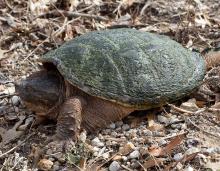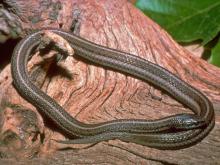Reptiles and Amphibians
Media

Species Types
Scientific Name
Agkistrodon contortrix
Description
The eastern copperhead is the most common venomous snake in Missouri. Its color varies from grayish brown to pinkish tan, with distinctive hourglass-shaped crossbands.
Media

Species Types
Scientific Name
Nerodia sipedon sipedon (northern watersnake) and N. s. pleuralis (midland watersnake)
Description
The northern watersnake and midland watersnake are Missouri's two subspecies of common watersnake. Together they occur statewide. Color is variable: gray, tan, or reddish brown with dark crossbands or blotches. The belly is cream-colored with red, brown, or black spots or half-moon markings.
Media

Species Types
Scientific Name
Thamnophis sirtalis sirtalis (eastern gartersnake) and T. s. parietalis (red-sided gartersnake)
Description
The eastern gartersnake and red-sided gartersnake are Missouri's most common gartersnakes. The color is variable, but there are normally three yellowish stripes, one down the back and one on each side. There are narrow black bars between the scales along the upper lip.
Media

Species Types
Scientific Name
Chelydra serpentina
Description
A large aquatic turtle with a big pointed head, long thick tail, and small lower shell, the eastern snapping turtle is common throughout the state, anywhere there is permanent water.
Media

Species Types
Scientific Name
Pantherophis obsoletus
Description
The western ratsnake, a glossy black snake, is one of Missouri’s largest and most familiar snakes. Its size and dark color make it seem imposing, but it is as harmless to humans as it is bad news for rodents.
Media

Species Types
Scientific Name
Tropidoclonion lineatum
Description
The lined snake looks similar to a gartersnake. It is brown to grayish brown, with three lighter-colored stripes down the length of its body and a double row of half-moon-shaped markings along the belly. It occurs mainly in the northwestern part of the state, along the northern border, with a separate population in the St. Louis area.
Media

Species Types
Scientific Name
Heterodon gloydi
Description
In Missouri, the dusty hog-nosed snake is found only in a few southeastern counties. This nonvenomous snake is a species of conservation concern. Like other hog-nosed snakes, it has several interesting defensive behaviors.
See Also
About Reptiles and Amphibians in Missouri
Missouri’s herptiles comprise 43 amphibians and 75 reptiles. Amphibians, including salamanders, toads, and frogs, are vertebrate animals that spend at least part of their life cycle in water. They usually have moist skin, lack scales or claws, and are ectothermal (cold-blooded), so they do not produce their own body heat the way birds and mammals do. Reptiles, including turtles, lizards, and snakes, are also vertebrates, and most are ectothermal, but unlike amphibians, reptiles have dry skin with scales, the ones with legs have claws, and they do not have to live part of their lives in water.





















